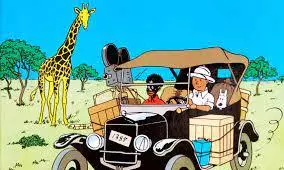
Tintin in the Congo reissue stirs debate on colonialist depictions
text_fieldsA reissued edition of the Tintin comic books has ignited debate among anti-racism groups due to its portrayal of colonialist themes, sparking varied reactions amidst criticism over its depiction of Africans.
Originally published in 1931 by Belgian comic artist Herge, "Tintin in the Congo" is the second volume in "The Adventures of Tintin" series.
The narrative revolves around Tintin, an intrepid reporter, embarking on a journey to Belgian Congo, a former colony of Belgium, encountering native populations, wildlife, and a gang of American diamond smugglers.
In recent years, this comic strip has faced increased scrutiny for its racist and colonialist portrayal of the indigenous population in Congo.
The latest edition, released alongside two other books in the Tintin series, includes a preface contextualising the colonial era and attempts to explain the historical setting of the original narrative. Changes within the storyline include a revision where Tintin, previously seen teaching a Congolese child about Belgium, now educates the child in mathematics.
Furthermore, the cover art has been modified, replacing Tintin's depiction seated alongside a black child with a new image of him confronting a lion.
Patrick Lozes, the founder of CRAN (a federation of anti-racism associations), acknowledges the addition of the preface as a positive step towards contextualising the material, calling it a move "in the right direction."
The preface, written by Philippe Goddin, head of the Friends of Herge association, largely aims to defend Herge's legacy against allegations of racism. Goddin emphasises Herge's stance against such accusations, asserting that the artist satirised both white and black characters and defended himself against charges of racism.
Pascal Blanchard, a historian specialising in colonialist propaganda, finds fault with the reissue, expressing surprise at the lack of a formal announcement regarding the changes and criticising the content of the new preface.
Debates surrounding Herge's intentions resurface, challenging the notion that his work was merely reflective of the era. Herge himself admitted in 1975 that his knowledge of the Belgian Congo was limited to prevalent conversations of the time, conceding that his portrayal of Africans was rooted in a paternalistic viewpoint.
Recognised as a leading cartoonist of the 20th century, Herge's unique artistic style left an indelible mark, influencing prominent artists like Andy Warhol and Roy Lichtenstein. The enduring legacy of Tintin's adventures spans translations into 130 languages, over 260 million copies sold worldwide, and adaptations into TV shows and Hollywood films.























